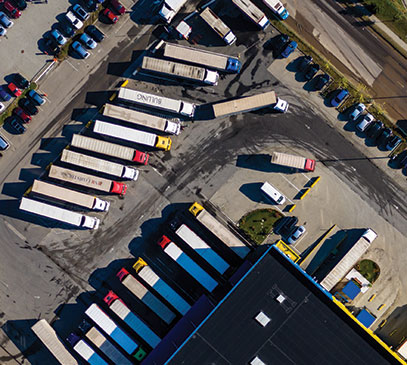Yard Management Systems (YMS): A must-have for the modern operation
Interest in yard management systems (YMS) is growing as the software helps more companies automate processes, speed up trailer turnaround times, and save money.
The warehouse or distribution center (DC) yard has always been one of those places that fits squarely in between two major logistics components—the warehouse and the open road—but it hasn’t always been given the right amount of attention when it comes to infrastructure and technology investment.
In fact, it has often been said that the yard is considered the “black hole” of the supply chain, a place where visibility is lost, clipboards serve as a mainstay for tracking, and guesswork takes over.
While yards may have historically been taken for granted, many shippers were in the process of building better yard visibility pre-pandemic. Those efforts were stepped up when the COVID-19 supply chain shortages went into effect and e-commerce volumes spiked. At that point, it seems, companies quickly realized that both their yards and loading docks had the potential to become real “pinch points” during times of crisis.
Yard management systems (YMS) are now playing a key role in helping companies alleviate those pinch points and use technology to track trucks; monitor trailer dwell time; check drivers in and out of the yard; and monitor traffic flow, among other things. In return, shippers are able to improve efficiencies, safety, compliance and customer service—all of which help them improve profitability and gain competitive advantage.
Retailers are particularly interested in getting better control and visibility in their yards and on their loading docks, and for good reason. During the height of the pandemic-driven supply chain shortages, retailers were among the first to deal with empty shelves, lack of inventory, and frustrated customers.
“Especially in retail right now, we’re seeing a lot of interest in YMS, with a particular emphasis on prioritizing which trailers to unload first,” says Howard Turner, director, supply chain systems at St. Onge Company. Retailers that have inventory sitting in trailers out in the yard, for example, are using YMS to effectively “extend” their existing warehouse management systems (WMS) out into the yard.
Turner says more third-party logistics companies (3PLs) are also taking an interest in YMS and learning more about how the software can help them better orchestrate the flow of goods in and out of their own yards. “At this point,” he adds, “both YMS and WMS have become important components of just about every customer project that we work on.”
YMS adoption is growing

Vamshi Rachakonda, VP, manufacturing, automotive and life sciences at Capgemini Americas, is also seeing growing interest in YMS as companies look to plug up any visibility gaps that may exist in their end-to-end supply chain networks.
“We’re seeing an increase in YMS adoption,” says Rachakonda. “Some of the increase is due to the post-pandemic effect, with global supply chain management as a whole becoming a major challenge for companies. They’re all working to become even more efficient, resilient and flexible. That, in turn, is driving the need for transformation.”
The C-suite is another driving factor behind the push to adopt more yard management systems. Knowing the impact that supply chain has on their companies’ bottom lines, CEOs, CFOs and other leaders are signing off on IT investments that help reduce costs, improve efficiency and speed up delivery times. The latter is especially important at a time when 90% of consumers view 2-day to 3-day delivery as a “baseline” and 30% expect same-delivery of their orders.
“More C-suite executives view the supply chain as an opportunity for digital transformation, and YMS is more and more becoming an integral part of those [efforts],” says Rachakonda, who recalls a time when shippers invested in WMS and transportation management systems (TMS) as a rule, with YMS being more of an afterthought. That sentiment has changed as supply chains have become more complex, intertwined and in some cases, constrained.
“Due to these and other factors, we’re seeing more YMS platforms worked into a company’s overall digital transformation efforts,” says Rachakonda. “Adoption of the software hasn’t quite reached what I expected it to, but it’s definitely higher than it was just a few years ago.”
Rachakonda says that the dock is also getting more attention these days as organizations view this critical “conduit” as a larger partner of the supply chain, versus just a conveyance for getting stuff on and off of trucks. Even slight improvements at the dock, for example, can have significant, positive effects both upstream and downstream in the supply chain. “We’re definitely seeing more interest in digitization that incorporates dock [management] as part of the overall solution,” he adds.
Surge in interest
During the pandemic, shippers turned to YMS to help them deal with the immediate need for social distancing, contactless yard check-ins and other ways to protect both driver and employees during the outbreak.
Simon Tunstall, a director analyst at Gartner, says he’s seeing a new surge in interest in yard management systems. Now, companies are looking for software that can help them improve the flow of vehicles and goods in and out of their yards.
Vendors are responding to the shift by coming up with new solutions, capabilities and functionalities that help shippers address their flow issues. This is happening both at the best-of-breed and enterprise software provider levels. For example, Tunstall says both types of YMS providers are beginning to incorporate more machine vision capabilities into their solutions.
Similar to voice recognition, machine vision helps computers “see” using one or more video cameras, analog-to-digital conversation and digital signal processing. Using cameras, it captures visual information from the surrounding environment and then processes those images for use in various applications.
According to Tunstall, machine vision takes the more traditional optical character recognition (OCR) to new levels by capturing arrival and departure information for every container, trailer, chassis or tractor unit. Yard operations with “open gates” are especially good candidates for machine vision-equipped YMS applications, but Tunstall says he’s also seeing interest from organizations that want to replace their current radio frequency identification (RFID) based trailer-tracking setups.
“They’re looking for an alternative to the classic RFID tag being slapped on the trailers and containers as they arrive onsite,” says Tunstall, who is also seeing more interest in using “visual data” to reduce the need for physical yard checks and other manual-intensive processes. He says software vendors like Blue Yonder and Manhattan are among those that are also using machine vision to drill down into the condition of each vehicle as it enters, dwells and then leaves the yard.
“We’re also seeing more manufacturers looking to reduce the impact of late, delayed or even missing trailers,” says Tunstall. “The fact that a YMS can be rolled out independently of other systems—and in some cases very quickly—and integrated with other, existing systems makes the software attractive when budgets are tight.” And while YMS adoption rates are “nowhere near that of WMS or TMS,” Tunstall says, “they are growing.”
In some cases, the siloed nature of a company’s various departments can stand in the way of a YMS investment, which may not always be seen as “critical” for all of those departments. For example, YMS helps companies reduce detention fees imposed by carriers when trucks have to “dwell” for too long in the yard or at the dock. However, oversight of those fees isn’t always on the same budget as one focused on improving the flow of orders through the DC or warehouse.
Because of this, the broader company may not recognize the real need for a new yard management system. “The areas where YMS can help aren’t always on the same buyer’s budget as the person who is concerned about yard management,” Tunstall explains. “Because of this, the immediate benefit of YMS isn’t always obvious, depending on who is looking at it and from which angle.”
What’s coming next?
Looking ahead, Tunstall sees rising fuel costs and inflation as two of the macro factors that will continue to drive interest in yard management systems. At an operational level, he says the need for improved coordination of yard-based equipment may also drive more organizations to implement such systems.
In many cases, the catalyst for change will likely continue to be the additional fees that companies pay when trailers and containers dwell out in their yards for longer than expected. With many companies focused on cost reduction right now, a company that still uses clipboards and walkie-talkies to manage its yard can see some real benefits from a yard management system.
In the future, Rachakonda also expects to see more companies using GPS tracking, RFID, predictive analytics and automation to get out in front of—and potentially solve—potential yard bottlenecks before those issues turn into real problems. He’s also seeing a bigger focus on sustainability, container movement optimization and fuel reduction, and says the yard can play an important role in helping companies achieve their goals in those areas.
Finally, with artificial intelligence (AI) and machine learning becoming increasingly critical in supply chain management, Rachakonda expects YMS to be even more “predictive” in the near future. Other vendors are looking more closely at the role that mobile technology plays in helping companies effectively manage and optimize their yards. “These are just a few of the trends that I’m seeing now,” he says, “and that I think may make YMS an even more important element of the broader supply chain going forward.”
Article Topics
Capgemini News & Resources
Risk Management: Building resilient supply chains in a risky world Reverse logistics in need of some love 2024 WMS Update: At the intersection of warehousing and e-commerce 6 TMS Trends for 2024 Yard Management Systems (YMS): A must-have for the modern operation Six emerging supply chain software trends to watch Steady march into the cloud More CapgeminiLatest in Supply Chain
C-Suite Executives Investing Heavily in Generative AI Trucking Industry Pushes Back on Government’s Electric Mandates Senators Take Aim at Amazon with Warehouse Worker Protection Act Maersk Sees Silver Lining in Red Sea Shipping Challenges Happy Returns Partners With Shein and Forever 21 to Simplify Returns S&P Global Market Intelligence’s Rogers assesses 2024 import landscape Frictionless Videocast: AI and Digital Supply Chains with SAP’s Darcy MacClaren More Supply ChainAbout the Author











